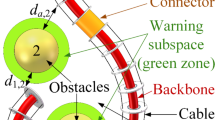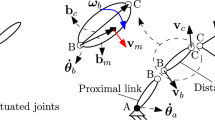Abstract
This paper presents a comprehensive study of the workspace, dynamic characteristics and accuracy of three planar flexible manipulators with 3-RPR, 2-RPR and 1-RPR structures moving at high speed. A geometrical procedure is employed to obtain the workspaces of the manipulators. The flexible intermediate links are modeled as the Euler–Bernoulli beams with fixed-free boundary conditions based on the assumed mode method. Using the Lagrange multipliers, a generalized set of differential algebraic equations of motion is developed for the planar RPR manipulators. Three moving constraints, which are obtained from an inverse kinematics analysis and applied to the actuated base joints, impose the end-effector to follow a high-speed circular motion as the desired trajectory. From this analysis, the dynamic performance of 1-RPR flexible serial manipulator and 2-RPR and 3-RPR flexible parallel manipulators in tracking a desired trajectory is evaluated. Based on the results, it is concluded that, in addition to the specific structure of the manipulator, the accuracy generally depends on the operation conditions. The results contest the general assertion which claims that parallel manipulators have more accuracy and stiffness than serial counterparts.











Similar content being viewed by others
References
Binaud N, Caro S, Wenger P (2011) Comparison of 3-RPR planar parallel manipulators with regard to their kinetostatic performance and sensitivity to geometric uncertainties. Meccanica 46(1):75–88
Bonev I, Zlatanov D, Gosselin C (2003) Singularity analysis of 3-DOF planar parallel mechanisms via screw theory. J Mech Des 25:573–581
Briot S, Bonev IA (2007) Are parallel robots more accurate than serial robots? CSME Trans 31(4):445–456
Briot S, Bonev IA (2008) Accuracy analysis of 3-DOF planar parallel robots. Mech Mach Theory 43(4):445–458
Briot S, Bonev I, Chablat D, Wenger P, Arakelian V (2008) Self-motions of general 3-RPR planar parallel robots. Int J Robot Res 27:855–866
Dwivedy SK, Eberhard P (2006) Dynamic analysis of flexible manipulators: a literature review. Mech Mach Theory 41:749–777
El-Khasawneh B, Alazzam A (2013) Kinematics, dynamics and vibration models for 3RPR parallel kinematics manipulator. In: ASME 2013 international mechanical engineering congress and exposition 14: vibration, acoustics and wave propagation. San Diego, California
Firoozabadi AE, Ebrahimi S, Amirian G (2015) Dynamic characteristics of a 3-RPR planar parallel manipulator with flexible intermediate links. Robotica 33:1909–1925
Guan L, Yun Y, Wang J, Wang L (2004) Kinematics of a tricept-like parallel robot. In: 2004 IEEE international conference on systems, man and cybernetics, pp 5312–5316
Kang B, Mills JK (2002) Dynamic modeling of structurally-flexible planar parallel manipulator. Robotica 20:329–339
Le TD, Kang HJ, Suh YS, Ro YS (2013) An online self-gain tuning method using neural networks for nonlinear PD computed torque controller of a 2-dof parallel manipulator. Neurocomputing 116:53–61
Merlet J-P (2006) Parallel robots, 2nd edn. Springer, Berlin, pp 4–7
Niaritsiry T-F, Fazenda N, Clavel R (2004) Study of the sources of inaccuracy of a 3 DOF flexure hinge-based parallel manipulator. In: IEEE international conference on robotics and automation, vol 4
Ogbobe P, Zhengmao Y, Jiang H, Yan C, Han J (2011) Formulation and evaluation of coupling effects between DOF motions of hydraulically driven 6 DOF parallel manipulator. Iran J Sci Technol, Trans Mech Eng 35(2):143–157
Pandilov Z, Dukovski V (2014) Comparison of the characteristics between serial and parallel robots. Acta Technica Corviniensis-Bulletin of Engineering, Tome VII, Fascicule 1 (January–March), 143–160. ISSN:2067–3809
Pashkevich A, Chablat D, Wenger P (2009) Stiffness analysis of overconstrained parallel manipulators. J Mech Mach Theory 44(5):966–982
Patel YD, George PM (2012) Parallel manipulators applications—a survey. Modern Mech Eng 2:57–64
Piras G, Cleghorn WL, Mills JK (2004) Dynamic finite-element analysis of a planar high-speed, high-precision parallel manipulator with flexible links. Mech Mach Theory 40(7):849–862
Rao SS (2007) Vibration of continuous systems. Wiley, New York
Rauf A, Kim S-G, Ryu J (2004) A new measurement device for complete parameter identification of parallel manipulators with partial pose measurements. In: The 4th Chemnitz parallel kinematics seminar. Chemnitz, Germany, pp 89–106
Seifried R, Burkhardt M, Held A (2013) Trajectory control of serial and parallel flexible manipulators using model inversion. Multibody Dyn 28:53–75
Song J-I, Mou J, King C (1999) Error modeling and compensation for parallel kinematic machines. In: Parallel kinematic machines, advanced manufacturing series. Springer, London, pp 171–187
Staicu S (2009a) Power requirement comparison in the 3-RPR planar parallel robot dynamics. Mech Mach Theory 44(5):1045–1057
Staicu S (2009b) Inverse dynamics of the 3-PRR planar parallel robot. Robot Auton Syst 57(5):556–563
Staicu S (2009c) Power requirement comparison in the 3-RPR planar parallel robot dynamics. Mech Mach Theory 44:1045–1057
Staicu S (2013) Joint forces in dynamics of the 3–RRR planar parallel robot. Int J Mech Robot 1(4):283–300
Staicu S, Chablat D (2012) Internal joint forces in dynamics of a 3-PRP planar parallel robot. Proc Rom Acad, Ser A 13(3):235–242
Staicu S, Carp-Ciocardia DC, Codoban A (2007) Kinematics modelling of a planar parallel robot with prismatic actuators. UPB Sci Bull, Series D 69:3–14
Sudhakar U, Srinvas J (2013) A stiffness index prediction approach for 3-RPR planar parallel linkage. Int J Eng Res Technol 2(9):2747–2751
Tsai LW, Joshi S (2001) Comparison study of architectures of four 3 degree-of-freedom translational parallel manipulators. In: Proceedings of the 2001 IEEE Seoul, Korea, international conference on robotics and automation
Viliani NS, Zohoor H, Kargarnovin MH (2012) Vibration analysis of a new type of compliant mechanism with flexible-link using perturbation theory. Math Prob Eng 1–19, Article ID 857064. doi:10.1155/2012/857064
Wavering AJ (1999) Parallel kinematic machine research at NIST: past, present and future. In: Boër CR, Molinari-Tosatti L, Smith KS (eds) Parallel kinematic machines, advanced manufacturing series. Springer, Berlin, pp 17–31
Williams RL, Joshi AR (1999) Planar parallel 3-RPR manipulator. In: Proceedings of the sixth conference on applied mechanisms and robotics, Cincinnati OH
Wu J, Wang JS, Wang LP, You Z (2010a) Performance comparison of three planar 3-DOF parallel manipulators with 4-RRR, 3-RRR and 2-RRR structures. Mechatronics 20(4):510–517
Wu J, Wang JS, Wang LP (2010b) A comparison study of two planar 2-DOF parallel mechanisms: one with 2-RRR and the other with 3-RRR structures. Robotica 28(10):937–942
Wu J, Wang JS, You Z (2011) A comparison study on the dynamics of planar 3-DOF 4-RRR, 3-RRR and 2-RRR parallel manipulators. Robot Comput Integr Manuf 27:150–156
Wu J, Li T, Wang JS, Wang LP (2013) Performance analysis and comparison of planar 3-DOF parallel manipulators with one and two additional branches. J Intell Robot Syst 72(1):73–82
Zhang D, Gao Z, Su X, Li J (2012) A comparison study of three degree-of-freedom parallel robotic machine tools with/without actuation redundancy. Int J Comput Integr Manuf 5(3):230–247
Zhao Y, Gao F (2009) Dynamic performance comparison of the 8PSS redundant parallel manipulator and its non-redundant counterpart—the 6PSS parallel manipulator. Mech Mach Theory 44(9):991–1008
Author information
Authors and Affiliations
Corresponding author
Appendix
Appendix
Mass matrix:
Stiffness matrix:
\(\,\,{\mathbf{K}}_{\eta \eta } = \frac{\text{EI}}{{l^{3} }}\left[ {\begin{array}{*{20}c} {{\hat{\mathbf{K}}}} & {\mathbf{0}} & {\mathbf{0}} \\ {\mathbf{0}} & \ddots & {\mathbf{0}} \\ {\mathbf{0}} & {\mathbf{0}} & {{\hat{\mathbf{K}}}} \\ \end{array} } \right] \in R^{nr \times nr} ,{\hat{\mathbf{K}}} = \left[ {\begin{array}{*{20}c} {\int_{0}^{1} {\psi_{1}^{{{\prime \prime }2}} {\text{d}}\xi } } & \cdots & 0 \\ \vdots & \ddots & \vdots \\ 0 & \cdots & {\int_{0}^{1} {\psi_{r}^{{{\prime \prime }2}} {\text{d}}\xi } } \\ \end{array} } \right] \in R^{r \times r} ,\)
Coriolis and centrifugal forces:
Jacobian matrix:
where \(s2_{i} = \left( {\rho_{i} + l} \right) \sin \theta_{i} + \cos \theta_{i} \sum\nolimits_{j = 1}^{r} {\eta_{ij} \psi_{j} \left( 1 \right)} \,\,{\text{and }}c2_{i} = \left( {\rho_{i} + l} \right) \cos \theta_{i} - \sin \theta_{i} \sum\nolimits_{j = 1}^{r} {\eta_{ij} \psi_{j} \left( 1 \right)} \,\,\)
where \(s3_{i} = r\sin (\phi_{i} + \phi_{p} ),c3_{i} = r\cos (\phi_{i} + \phi_{p} )\)
Rights and permissions
About this article
Cite this article
Ebrahimi, S., Eshaghiyeh-Firoozabadi, A. Dynamic Performance Evaluation of Serial and Parallel RPR Manipulators with Flexible Intermediate Links. Iran J Sci Technol Trans Mech Eng 40, 169–180 (2016). https://doi.org/10.1007/s40997-016-0019-3
Received:
Accepted:
Published:
Issue Date:
DOI: https://doi.org/10.1007/s40997-016-0019-3




